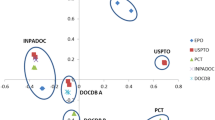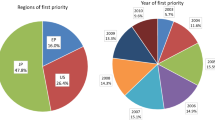Abstract
Most studies of patents citations focus on national or international contexts, especially contexts of high absorptive capacity, and employ examiner citations. We argue that results can vary if we take the region as the context of analysis, especially if it is a region with low absorptive capacity, and if we study applicant citations and examiner-inserted citations separately. Using a sample from the Valencian Community (Spain), we conclude that (i) the use of examiner-inserted citations as a proxy for applicant citations, (ii) the interpretation of non-patent references as indicators of science-industry links, and (iii) the traditional results for geographical localization are not generalizable to all regions with low absorptive capacity.
Similar content being viewed by others
References
ACCID (2005), Análisis de la contribución de la I+D universitaria al desarrollo económico de la Comunidad Valenciana. In: Alto Consejo Consultivo en Investigación y Desarrollo de la Presidencia de la Generalitat Valenciana, Informe anual sobre el estado de la investigación, el desarrollo y la tecnología en la Comunidad Valenciana. Valencia, Generalitat Valenciana.
Acosta, M., Coronado, D. (2002), Las relaciones ciencia-tecnología en España. Evidencias a partir de las citas científicas en patentes. Economía Industrial, 346: 27–46.
Acosta, M., Coronado, D. (2003), Science-technology flows in Spanish regions. An analysis of scientific citations in patents. Research Policy, 32: 1783–1803.
Alcácer, J., Gittelman, M. (2006), Patent citations as a measurement of knowledge flows: The influence of examiner citations. Review of Economics and Statistics, 88(4): 774–779.
Almeida, P., Kogut, B. (1997), The Exploration of Technological Diversity and the Geographic Localization of Innovation. Small Business Economics, 9: 21–31.
Almeida, P., Kogut, B. (1999), Localization of knowledge and the mobility of engineers in regional networks. Management Science, 45(7): 905–917.
Azagra-Caro, J. M., The regional dimension of university-industry interaction. In: SURIÑACH, J., MORENO, R., VAYÁ, E. (Eds), Knowledge Externalities, Innovation Clusters and Regional Development. Cheltenham and Northampton, Edward Elgar, (2007a).
Azagra-Caro, J. M. (2007b), What type of faculty member interacts with what type of firm? Some reasons for the delocalisation of university-industry interaction. Technovation, 27: 704–715.
Azagra-Caro, J. M., Archontakis, F., Gutiérrez-Gracia, A., Fernández-de-Lucio, I. (2006), Faculty support for the objectives of university-industry relations versus degree of R&D cooperation: the importance of regional absorptive capacity. Research Policy, 35(1): 37–55.
Beise, M., Stahl, H. (1999), Public research and industrial innovations in Germany. Research Policy, 28(4): 397–422.
Callaert, J., van Looy, B., Verbeek, A., Debackere, K., Thus, B. (2006), Traces of prior art: An analysis of non-patent references found in patent documents. Scientometrics, 69(1): 3–20.
Cohen, W. M., Levinthal, D. A. (1990), Absorptive capacity: a new perspective on learning and innovation. Administrative Science Quarterly, 35(1): 128–152.
Cooke, P. (1992), Regional innovation systems: competitive regulation in new Europe, Geoforum, 23(3): 365–382.
Criscuolo, P., Verspagen, B. (2005), Does It Matter Where Patent Citations Come From? Inventor versus Examiner Citations in European Patents. ECIS Working Papers 05.06.
Harhoff, D., Narin, F., Scherer, F. M., Vopel, K. (1999), Citation frequency and the value of patented inventions. Review of Economics and Statistics, 81(3): 511–515.
Jaffe, A., Trajtenberg, M., Fogarty, M. S. (2000), Knowledge spillovers and patent citations: Evidence from a survey of inventors. American Economic Review, 90(2): 215–218.
Jaffe, A., Trajtenberg, M. (1996), Flows of knowledge from universities and federal laboratories: Modeling the flow of patent citations over time and across institutional and geographic boundaries. PNAS, 93: 12671–12677.
Leydesdorff, L., Meyer, M. (2003), The Triple Helix of university-industry-government relations. Scientometrics, 58(2): 191–203.
Mansfield, E. (1998), Academic research and industrial innovation: An update of empirical findings. Research Policy, 25(3): 773–76.
Meyer, M. (2002), Tracing knowledge flows in innovation systems. Scientometrics, 54(2): 193–212.
Meyer, M. (2000), What is special about patent citations? Differences between scientific and patent citations. Scientometrics, 49(1): 93–123.
Michel, J., Bettels, B. (2001), Patent citations analysis: A closer look at the basic input data from patent search reports. Scientometrics, 51(1): 185–201.
Narin, F., Hamilton, K. S., Olivastro, D. (1997), The increasing linkage between U.S. technology and public science. Research Policy, 26(3): 317–30.
Narin, F., Noma, E. (1985), Is technology becoming science? Scientometrics, 7(3–6): 369–381.
Niosi, J., Bellon, B. (2002.), The absorptive capacity of regions. Colloque Economie Méditerranée Monde Arabe. Sousse 20–21 September.
Sampat, B. (2004), Examining Patent Examination: An Analysis of Examiner and Applicant Generated Prior Art. Working Paper, School of Public Policy, Georgia Institute of Technology.
Schmoch, U. (1993), Tracing the knowledge transfer from science to technology as reflected in patent indicators. Scientometrics, 26(1): 193–211.
Thompson, P. (2006), Patent citations and the geography of knowledge spillovers: Evidence from inventor- and examiner-added citations. Review of Economics and Statistics, 88(2): 383–388.
Todt, O., Gutiérrez-Gracia, A., Fernández-de-Lucio, I., Castro-Martínez, E. (2007), The regional dimension of innovation and the globalization of science: the case of biotechnology in a peripheral region of the European Union. R&D Management, 37(1): 65–74.
Vega-Jurado, J., Gutiérrez-Gracia, A., Fernández-de-Lucio, I., Manjarrés-Henríquez, L. (2007). The effect of external and internal factors on firms product innovation. Research Policy, forthcoming.
Author information
Authors and Affiliations
Corresponding author
Rights and permissions
About this article
Cite this article
Azagra-Caro, J.M., Fernández-de-Lucio, I., Perruchas, F. et al. What do patent examiner inserted citations indicate for a region with low absorptive capacity?. Scientometrics 80, 441–455 (2009). https://doi.org/10.1007/s11192-008-2081-0
Received:
Published:
Issue Date:
DOI: https://doi.org/10.1007/s11192-008-2081-0




